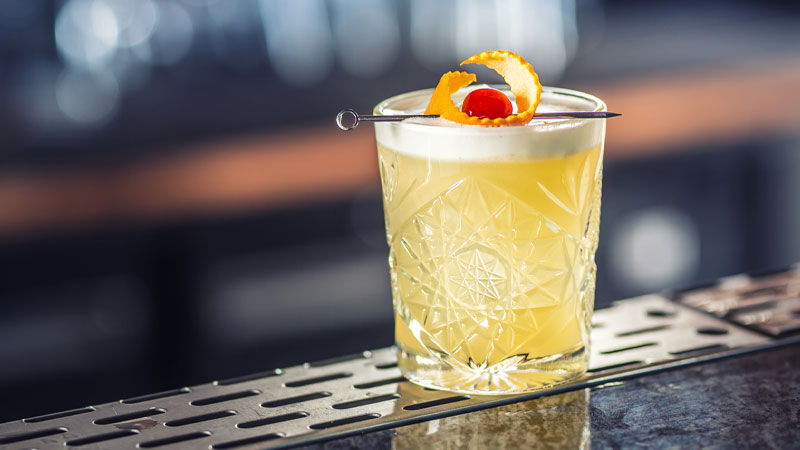To create any sour-style cocktail, all you need is a base spirit, citrus, and sugar. It’s a simple formula, yet perfecting simplicity is incredibly nuanced — especially when it comes to crafting an age-old classic like the Whiskey Sour. The cocktail has taken on various forms over the years, but the common version served at bars today is made with the preferred whiskey of the day, bourbon, lemon juice, simple syrup, and egg white — a later addition to the classic sour.
The sour cocktail derives from the punch — the monarch of all cocktails, and a popular drink style originating in the 1600s. According to drinks historian David Wondrich, the punch cocktail had a long history that started with British sailors who turned to making mixed drinks with local ingredients after their beer spoiled while sailing in the tropics. Nearly 100 years later, the cocktail-trendsetting British sailors accidentally created the sour cocktail as well by mixing the citrus juices that they were drinking to prevent scurvy with whichever spirits they had on board at the time. But it wasn’t until the 19th century that the Whiskey Sour came into vogue.
At the peak of its popularity, between the 1860s and 1960s, the Whiskey Sour was declared “one of the cardinal points of American drinking,” as Wondrich states in his book “Imbibe!” Today, whether you order the classic Whiskey Sour, or one of its many variations that you’ll find on menus, there are a few best practices to follow when making one at home to ensure there is a balance of sweet and sour with the optimal texture and aroma.
We chatted about the dos and don’ts for crafting the best Whiskey Sour with modern bartenders who have some strong opinions on which whiskey to use, whether or not egg white should be included, and more. By following these five tips, you’ll be on your way to mastering the Whiskey Sour and its variations in no time.
What to Do When Making a Whiskey Sour
Include an egg white for optimal texture.
A Whiskey Sour made with an egg white is formally referred to as the Boston Sour, but if you order a standard Whiskey Sour at a bar today, almost every contemporary bartender will serve it to you with an egg white. “Traditionally, the first sours were made without egg white,” says Patrick Abalos, owner and partner of Houston’s Night Shift. “I prefer it with egg white. It adds depth and body to the cocktail, especially with a good whiskey.”
“Egg whites add texture and mouthfeel,” adds Aaron Wall, co-owner of London-based Irish cocktail bar Homeboy. “I’ve no problem using a substitute [like aquafaba], but it has to give the same results.”
With an emulsifier like egg white, or the vegan chickpea brine aquafaba, a Whiskey Sour is rich, frothy, velvety, and well structured to tame the sourness of the citrus, making the cocktail perfectly balanced. Without it, the Whiskey Sour loses depth and tends to feel out of sync.
Choose a high-proof whiskey with a flavor profile you like.
The most important ingredient in the Whiskey Sour is (you guessed it!) the whiskey. No matter how fresh the citrus is, your Whiskey Sour will be substandard if you skimp on the whiskey — but you don’t need to break the bank. We recommend spending at least $20 on a bottle to make sure you’re getting a reliable, high-quality whiskey.
Once you’ve checked the box for quality, it’s time to think about your flavor preferences, and which whiskey aligns best with your tastes. If you enjoy sweeter drinks with a touch of smoke, then bourbon might be your best bet; for the smoke lover, consider peated whiskey; if you like dry and spicy cocktails, rye is the way to go; or if you prefer the flavor of grain, the characteristics of a single malt could suit your fancy.
At the end of the day, you know what you like best. And our bartending experts also have recommendations.
“A higher-rye bourbon works best as a base,” Abalos says. “It has more twang from the mash bill. I also use higher-proof styles, something in the 90 to 100 proof range. With sours you have a lot of dilution and some whiskey just doesn’t hold up.” The star of the show should be the whiskey, so it’s vital to consider the ABV, or proof, when crafting your sour.
Wall, unsurprisingly, recommends Irish whiskey due to its versatility and overall balance. Most of these whiskeys are pot distilled, full-bodied, and packed with flavor. Although Irish whiskey isn’t called for often, the tree fruit and floral characteristics make it a foolproof option for making a Whiskey Sour.
Put your own spin on the classic template.
The sour is one of the easiest cocktail templates to put your own personal touch on because of its simplicity. Swap the simple syrup for a honey syrup and you have yourself a Gold Rush; build on that template with some spicy and smoky flavors, and you have yourself a Penicillin. As long as you keep the balance between sour, strong, and sweet, you’re golden.
“One of my bartenders created a version of the Whiskey Sour that includes a homemade pineapple oleo saccharum, whiskey, bergamot liqueur, lychee, and fresh lemon and orange juice,” says Patricio Rio, head bartender at Kimpton Seafire Resort + Spa’s Avecita in Grand Cayman. The cocktail is “delicious, aromatic, and flavorful, capped with an egg white to encapsulate all the aromas floating around in this diverse take on a classic.”
If you’re new to mixology, the best place to start is by crafting flavored simple syrups to pair with the whiskey. This will add some nuance in flavor while also maintaining the sweet and sour balance. For the experienced drink makers, consider adding in an amaro, bitter, or split whiskey base if you feel comfortable balancing the various notes at play.
What Not to Do When Making a Whiskey Sour
Don’t slack on the shaking.
There is something to be said about the importance of the technique and glassware for serving a Whiskey Sour. To be served perfectly it must both be shaken well, and shaken to completion, to achieve perfect dilution. If you opt for a rich-bodied Whiskey Sour with an egg white, the technique must be focused as the shaking comes in two parts: the wet shake (with ice) and the dry shake (without ice).
“It is important to have the proper head of foam [when mixing with egg white],” Abalos explains. “Generally when we do training on shaking egg white cocktails, we tell bartenders to pay attention to the sound and feel of the tin. If it still sounds clanky it is not ready; you want it to feel and sound like a tennis ball is in your tin.”
Start with a vigorous wet shake to emulsify the ingredients and add the necessary dilution to balance the cocktail. Then, dry-shake to further dial in the texture, adding to the frothiness of the Whiskey Sour.
Many bartenders will serve a Whiskey Sour in a rocks glass over ice, even though both Wall and Abalos make the point that it is meant to be served up. While both methods yield a delicious sour, serving the Whiskey Sour over one large cube is our recommended serve as it dilutes slowly due to the ice employed, and keeps your cocktail chilled over the drinking session. If you opt for it up, however, a Nick and Nora glass is your best service vessel.
Don’t forget to garnish the cocktail.
A garnish should always add something to a cocktail. Whether visual appeal or an aromatic quality, both factors are important to consider. If you opt for the common Whiskey Sour with an egg white, the garnish is crucial.
An egg white cocktail that sits for a few minutes without any aromatic element develops notes of sulfur from the eggs. To avoid having an eggy-smelling Whiskey Sour, there are a few garnish options worth considering. “Usually I like to do some wild Angostura bitters dashes or drawings on top of the egg white froth to ‘wow’ the guest,” says Rio. “But anything from an orange or lemon twist, to a couple cherries or a dehydrated slice of citrus would do.”
It really comes down to your flavor preference, but the garnish is essential and will add the aromatic element that is necessary to complete your perfect Whiskey Sour.

